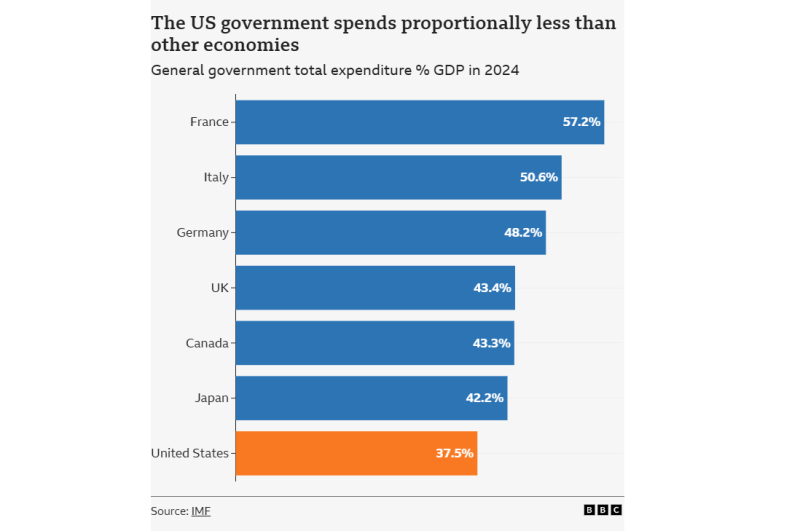The $2 trillion cuts would amount to a cut of about 30% in total federal government spending. How realistic is that?
The head of Tesla and social networking site X (formerly Twitter), Elon Muskhe said last month at a rally of the US president-elect Donald Trump in New York that it would be possible to cut “at least 2 trillion dollars’ from US government spending by fighting ‘waste’.
Musk has now been appointed by Trump as co-head of the new Government Efficiency Agency, which gives him the opportunity to try to implement his plans, as the BBC notes in its analysis.
In the most recent fiscal year (October 2023 to September 2024), the US federal government spent $6.75 trillion. dollars according to the US Treasury Department. This means that Musk’s proposed cuts of 2 trillion dollars would equate to about a 30% cut in total federal government spending – also known as national spending in other countries.
But how realistic is Musk’s proposal?
To answer this question, costs must be considered.
About $880 billion (13% of total US government spending) goes to interest payments on the debt, meaning that this spending cannot be reduced without bankrupting the US government.
About 1.46 trillion dollars (22%) goes to Social Security, which mostly means pensions for Americans past retirement age. This is an expense which is “mandatory”, meaning it must be spent by law for those who are entitled to it.
Other large mandatory government expenditures include Medicare—a government-sponsored health insurance program that primarily serves Americans over age 65.
The US government’s so-called “discretionary” spending – spending that is not permanently enshrined in law but must be voted on annually by US lawmakers – includes defense ($874 billion, 13%), transportation ($137 billion, 2% ) and education, training, employment and social services ($305 billion, 5%).
In total, according to the Congressional Budget Office, discretionary spending accounts for about 25% of the fiscal year 2023 total, with more than half of that going to defense.
In theory, discretionary spending would be easier for the Trump administration to cut than mandatory spending.
Donald Trump has said Musk — and his co-head of the new Government Efficiency Agency, Vivek Ramaswamy — will achieve savings by fighting government red tape, cutting excessive regulations and restructuring government agencies. In an interview with the BBC in April 2023, Musk claimed to cut X’s staff from 8,000 to 1,500 after the social network’s acquisition in 2022.
However, if the total of 2 trillion dollars in US government spending savings that Musk is now targeting came from discretionary spending, analysts estimate that entire services — from transportation to agriculture to homeland security — would have to be shut down entirely. Discretionary spending represented only 1.7 trillion. dollars in 2023.
Musk has not specified whether he will aim to save 2 trillion. dollars in a single year or longerbut many American public finance experts, including those in favor of reducing US government spending in principle, are wary of finding cuts of this scale in the near future without either collapsing the delivery of important government functions or causing great displeasure of public opinion.
After taking control of the House of Representatives in 2022, Republican lawmakers have struggled to pass legislation for significantly smaller cuts of $130 billion in discretionary government spending after facing opposition from other Republicans.
It’s also important to note that Donald Trump campaigned on the agenda of making Social Security more financially generous by eliminating the income tax paid on it. And, on defense, Trump has said he will build an “iron dome” around America, implying more spending in that area, not cuts.
Total US federal government spending as a percentage of the US economy in 2024 was about 23% according to the US Treasury Department, a significantly smaller share than government spending in other developed countries. However, a large portion of government spending in the US, including almost all school spending, occurs at the state rather than the federal level.
The International Monetary Fund has forecast that total US “general government spending”, which includes spending by individual states, will account for 37.5% of GDP in 2024, compared to 43% in the UK, 48 % in Germany and 57% in France.
Source: Skai
I am Janice Wiggins, and I am an author at News Bulletin 247, and I mostly cover economy news. I have a lot of experience in this field, and I know how to get the information that people need. I am a very reliable source, and I always make sure that my readers can trust me.











